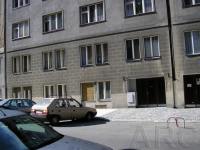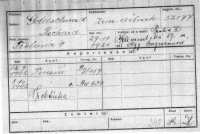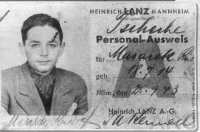 |
 |
 |
 |
 |
Richard matriculated in March 1939 and was accepted by the University of Prague in June of that year as a philosophy student, but anti –Jewish legislation meant that he could take up that syllabus. Instead he was offered a course reading economics. At Christmas 1938 his stepfather managed to obtain a permit for the entire family to travel to England, but ultimately he did not have the courage to leave everything he had built up in Czechoslovakia behind and start up again in another country. On 17 November 1939, students demonstrated after several of their colleagues had been executed and all Universities were closed. Richard then worked for his stepfather until 1940, when he was sent to a farm outside of Prague where his family thought he would be safer. There he stayed until 2 September 1942, when the Nazis summoned him to the Mustermesse, a huge exhibition-hall in Prague, where he remained until 12 September 1942, before being transported on transport BG417 to Terezin (Theresienstadt), a village built around the fortress of that name. The address for Richard Goldschmid Glazer was stated as 17 Klimenstka Street, Prague, a modern-day photograph of which is shown below
 |
| Modern day photo - Klimentska 17 |
 |
“We travelled for two days. On the morning of the second day we saw we had left Czechoslovakia and we were heading east. It wasn’t the SS guarding us, but the Schutzpolizei, the Police in green uniforms. We were in ordinary carriages and all the seats were filled. You couldn’t choose a seat; they were all numbered and reserved. In my compartment there was an elderly couple. I still remember: the good man was always hungry and his wife scolded him, saying they’d have no food left for the future.
Then, on the second day, I saw a sign for Malkinia. We went on a little farther. Then, very slowly, the train turned off the main line and rolled at a walking pace through a wood. While he looked out – we’d been able to open a window – the old man in our compartment saw a boy…cows were grazing…and he asked the boy in signs, `Where are we?’ And the kid made a funny gesture. This: (draws finger across his throat.)…Not in words, but in signs, we asked: `What’s going on here?’ And he made that gesture. Like this. We didn’t really pay much attention to him. We couldn’t figure out what he meant.”
He went on to describe his arrival at the Treblinka death camp.
“And suddenly the yelling and screaming started: `All out, everybody out!’ All those shouts, the uproar, the tumult! `Out! Get out! Leave the baggage!’ We got out, climbing over one another. We saw men wearing blue armbands. Some carried whips. We saw some SS men. Green uniforms, black uniforms…
We were a mass and the mass swept us along. It was irresistible. It had to move to another place. I saw the others undressing. And I heard: `Get undressed! You’re to be disinfected!’ As I waited, already naked, I noticed the SS men separating out some people. These were told to get dressed. A passing SS man suddenly stopped in front of me, looked me over and said: `Yes, you too, hurry up, join the others get dressed. You going to work here, and if you are good you can be a kapo – a squad leader.”
Glazar then described meeting up with his great friend Karel Unger:
“All I could think of then was my friend Karel Unger. He’d been at the back of the train in a section that had been uncoupled and left outside. I needed someone. Near me. With me. Then I saw him. He was in the second group. He’d been spared too. En-route he had learned somehow, he already knew. He looked at me. All he said was: `Richard, my father, mother, brother…’ He had learned on the way there.
(This) was about twenty minutes after arriving in Treblinka. Then I left the barracks and for the first time I saw the vast area that I soon learned was called `the sorting place.’ It was buried under mountains of all sorts of objects – mountains of shoes, of clothes ten metres high.I was overwhelmed and said to Karel:
'It’s a hurricane, a raging sea. We are shipwrecked but still alive and we can do nothing but watch out for every new wave, float on it, get ready for the next wave, and ride the wave at all costs. And nothing else…'”
He continued,
“We were taken to a barracks. The whole place stank. Piled high in a jumbled mass were all the things people could conceivably have brought. Bed linen, suitcases, everything, piled up in a solid mass. On top of it, jumping around like demons, there were people making bundles of things and carrying them outside. I was turned over to one of these men with a ‘Squad Leader’ armband. He shouted at me and I understood that I was to take a bed-sheet , bundle things into the sheet and take it outside. As I worked I asked him:
'What’s going on? Where are the ones who stripped?’ He replied in Yiddish: 'Dead! All Dead!’
It still hadn’t sunk in, I really didn’t understand. It was the first time I had heard Yiddish spoken. He didn’t say it very loud, and I noticed there were tears in his eyes. Suddenly he shouted at me and raised his whip. Out of the corner of my eye, I saw an SS man approaching. I understood I should not ask any more questions, just rush outside with the bundle.”
He described the ending of his first day in Treblinka:
“Greenery, and sand everywhere else. At night we were put in a barrack, which had a sandy floor, nothing else. We all dropped where we stood. Half asleep, I heard some men hang themselves. We didn’t react then. It seemed almost normal at that time. Just as it was normal that for everyone behind whom the gate of Treblinka closed, there was death , had to be death, for no one was supposed to be left to bear witness. I already knew that, three hours after arriving in Treblinka.”
He described the burning of the bodies, which began a month or so after his arrival:
“It was at the end of November 1942. They chased us away from our work and back to our barracks. Suddenly from behind the embankment separating the Totenlager, flames shot up. Very high. In a moment the whole countryside, the whole camp seemed ablaze. It was already dark. We went into the barracks and ate, and through a small window we saw the fantastic backdrop of flames of every imaginable colour: red, yellow, green, purple. Suddenly, one of us stood on a bed. We knew he had been an opera singer in Warsaw. His name was Salve, and facing that curtain of fire, he began chanting a song, I had not heard before:
'Eli, Eli, (my God, my God) why has thou forsaken us? We have been cast into the fire before, but we have never denied Thy Holy law.’
He sang the words in Yiddish, while before him blazed the pyres on which they had begun then, in November 1942 to burn the bodies in Treblinka. That was the first time it happened. We knew that night that the dead of Treblinka would no longer be buried, they would be burned."
Of the Lazarett, Richard said:
“The Lazarett ('Infirmary’) was a little area very close to the ramp, to which the aged were led. I had to do this too. This execution site was not covered, just an open, roofless place, but screened by a fence, so no one could see in. The way in was through a narrow passage, very short, but somewhat similar to the `funnel.’ A sort of tiny labyrinth. In the middle there was a pit, to the left as one entered there was a little booth with a plank in it, like a springboard. If people were too weak to stand on it, then they’d have to sit on it, and then as the saying went in Treblinka jargon, the SS-Unterscharführer Miete, would 'cure each one with a single pill’ – a shot in the neck. In the peak periods, that happened daily. In those days the pit – and it was at least three and a half to four metres deep - was full of corpses.
There were also cases of children, who for some reason arrived alone, or were separated from their parents. These children were led to the 'infirmary’ and shot there. The 'infirmary’ was also for us, the Treblinka slaves, the last stop – not the gas chamber. We always ended up in the `infirmary."
Glazar described the “Dead Season” – January to March 1943:
“The 'Dead Season’, as it was called, began in February 1943 after the big transports from Grodno and Bialystok. Then nothing. Not a movement from late January, February and into March. Not a single transport. The entire camp was empty, and suddenly, everywhere there was hunger. It kept increasing. One day when the famine was at its peak, SS-Oberscharführer Kurt Franz appeared before us and told us: 'Starting tomorrow, transports will arrive again.’ We didn’t say anything, we just looked at one another and each of us thought: 'Tomorrow no more hunger.’ At that time, we were actively planning the rebellion. We all wanted to survive until the rebellion.
The transports came from an assembly camp in Salonika. They’d collected Jews from Bulgaria, and Macedonia. These were rich people; the transports bulged with possessions. Then an awful feeling gripped us, all of us, my companions as well as myself, a feeling of helplessness, of shame. For we threw ourselves on their food. A detail carried off a box full of crackers, another full of jam. They deliberately dropped these boxes, falling over each other, devouring the crackers, and jam. The trainloads from the Balkans brought us a horrible realization: we were the Treblinka factory workers and our lives depended on the whole manufacturing process, that is the slaughtering process at Treblinka…
(The Balkan transports consisted of) 24, 000 people, probably without even one sick person among them, not one invalid, all healthy and robust! I remember watching them from our barracks, already naked, milling amidst their baggage, and David Bratt said to me: "Maccabees! The Maccabees have arrived in Treblinka.’ Sturdy, physically strong people, unlike the others, fighters, yes they could have been fighters. It was staggering for us, for these were splendid people, wholly unaware of what awaited them. Wholly unaware. Never before had things gone so smoothly and quickly. Never. We felt ashamed and appalled and also that this couldn’t go on, that something had to happen. Not as an act by a few, but by all of us.
The idea was almost ripe back in November 1942. From about November 1942 we’d noticed we were being `spared’ in quotes. We noticed it, and we also learned that Stangl had decided it would be more efficient to hang onto trained people – specialists trained for various jobs such as sorters, corpse haulers, barbers to cut the women’s hair, and so on. And this is what later gave us the chance to prepare, to organise the uprising. We had a plan worked out January 1943, code-named 'The Hour’. At a set moment we were to attack the SS everywhere, seize their weapons and storm the Kommandantur. But it didn’t happen because the camp was at a standstill and because typhus had already broken out.”
 |
Liberated by the Americans, Glazar attended the Treblinka trials for a number of the former SS men in Germany during 1964/65, as well as the trial of Stangl in 1970.
In the post-war years, Glazar studied in Prague, Paris, and London, earning a degree in economics. After the failed uprising of the “Prague Spring” in 1968, he left Czechoslovakia with his family, and moved to Switzerland.
Richard Glazar helped ARC’s founder member M. Peters build a model of the Treblinka death camp, following a visit to Glazar’s flat in Berne in 1995.
Sadly, the model was not completed before Glazar committed suicide in Prague on 20 December 1997, following the death of his wife.
Sources:
Glazar, Richard. Trap with a Green Fence. Northwestern University Press, Evanston, Illinois, 1999.
Sereny, Gitta. Into that Darkness. Pimlico edition, London, 1995.
Lanzmann, Claude. Shoah – The Complete Text. Da Capo Press, New York, 1995.
Yad Vashem Central Database of Victims
© ARC 2005